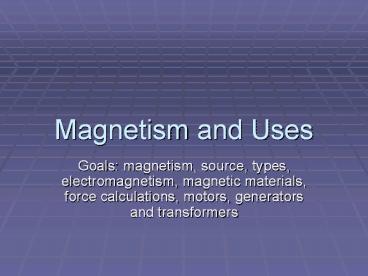Magnetism and Uses - PowerPoint PPT Presentation
1 / 10
Title:
Magnetism and Uses
Description:
Magnetism and Uses Goals: magnetism, source, types, electromagnetism, magnetic materials, force calculations, motors, generators and transformers – PowerPoint PPT presentation
Number of Views:142
Avg rating:3.0/5.0
Title: Magnetism and Uses
1
Magnetism and Uses
- Goals magnetism, source, types,
electromagnetism, magnetic materials, force
calculations, motors, generators and transformers
2
Magnetism
- Magnetism field force with north and south
poles - Alignment of magnetic domains
- Domains- groups of atoms with magnetic fields
that complement one another - Atoms exhibit magnetic properties because of the
spin of an unpaired electron (moving electric
field) (fourth quantum number) - Opposite poles attract and the same poles repel
- Field lines point away from North and toward the
South pole
3
Types of Magnets
- Permanent and an Electromagnet
- Permanent hold magnetic properties domains
are aligned bar and horseshoe - Magnetized in an electric current or a strong
magnetic field - Unmagnetized by shock, heat or another field
- Diamagnetic- fields cancel no magnetism Pb
- Paramagnetic- atoms are magnetic but not domains
Al
4
- Nonmagnetic- when permanent magnet is removed
there is no magnetism - Ferromagnetic strong magnetic properties Fe
Ni Co Nd - Earth and Stars
- Electromagnets coil with an iron core
- Advantages turned on and off and vary the
magnetic strength (lab) - Turns in the coil current size of core
- Why? Current - carrying conductor has a
magnetic field around it Right Hand Rule - Oersteds discovery- with a compass and current
discovered that the current produced a magnetic
field reversed by reversing the current
direction
5
Electromagnetism
- Magnetism produces electricity and electricity
produces magnetism - Faraday law of induction
- Electric motors and Generators
- Home wiring AC , current in opposite
directions repel magnetic fields in the same
direction attract - Motors electrical to mechanical energy
- Electromagnet in the core of the motor is pushed
by the field of the electromagnet continually as
the magnetic field is reversed easier in AC - Parts include armature (moving electromagnet),
rotor, brushes, permanent magnet and commutator
(switch) (Lab)
6
- Generator electric motor in reverse
- Mechanical energy into Electrical
- Energy easily moved by conductors and easily
converted to another form - Moving coil of wire within a magnetic field
induces a current in the wire - Produces AC because of the switch in direction
of magnetic fields in the permanent magnets - Faradays Law of Induction faster the solenoid
turns in the magnetic field the higher the
voltage - Turbine forced to turn by wind, falling water,
and expanding steam from burning coal or nuclear
power
7
- Transformers step-up or step-down voltage to
efficiently by increasing or decreasing the
number of coils around an iron core - V1 x N2 V2 x N1
8
Magnetic Field Strength
- Electric fields produce electric force per unit
of charge E k qq/r² E N/C - Magnetic fields produce magnetic force per unit
of charge depending on velocity
B F magnetic / q v B N/C m/s T - F mag B q v
- Magnetic Field produced by current
B F magnetic/ I x L B N/C/s m T
9
Uses of Magnetism
- Solenoids, speakers, doorbells, galvanometers,
motors and generators, ignition coils, CAT scans
and MRI.
10
Electromagnetic Waves
- Electromagnetic Wave transverse wave of
electromagnetic radiation - Energy is stored in electric and magnetic fields
and transferred in the form electromagnetic waves - Oscillating electric and magnetic fields
propagated perpendicular to one another - Produced by an exited electron (electric field)
returning to ground state - Quantized (Plank) Photon (Einstein)
- Dual Nature Particle and Wave-like































